Searching for a monitor arm can be tricky. There are so many things to take into consideration, such as how many monitors you have, monitor configuration, workstation environment, adjustment features, etc.
How do you know which options are a better fit for you than others? Well, this guide is going to help with just that.
In this article, we're going to answer the top 12 questions you need to ask yourself before buying a monitor arm. By answering each one, you'll be able to find your perfect monitor arm mount.
As you answer each question, you may want to jot down a few notes. This will help build the list of requirements for your best-fit monitor arm.
Watch the Video: How to Buy the Best Monitor Mount for Your Desk - answer these 12 questions
Top 12 questions to find your ideal monitor arm:
1. Is your monitor VESA compliant?
2. How many monitors do you want to support?
3. What’s weight of each monitor?
4. What’s the size of each monitor?
5. How would you like your monitors to be configured?
6. What is the width of your desk?
7. Are you looking to simply get your monitors off your desk or for a mount with more adjustability options?
8. How often are you needing to adjust the height of your monitors?
9. Is the back of your worksurface up against a wall or cubicle?
10. Will your monitor arm be placed in a corner of an L or U shaped desk?
11. How do you want to mount your monitor arm(s) - Grommet or Clamp?
12. What is your budget?Top 12 Questions to Help Choose the Best Monitor Arm
#1 Is your monitor VESA compliant?
It’s important that you check if your computer monitor is VESA (Video Electronics Standards Association) compliant.
VESA provides the guidelines for basic hole patterns that are used to make attaching a display to a mount much easier. These patterns are measures between the hole both vertically and horizontally. The most common VESA compliant hold dimensions are 75 x 75 mm and 100 x 100 mm (monitors weighing less than 30 lbs.).
To see if your monitor is VESA compatible, you can take a quick peek at the back of the monitor and look for the hole pattern. If it’s attached to an existing stand, you may need to remove the mount to reveal the hole pattern. Otherwise, an internet search of your monitor’s make and model should be able to help.
iMacs are typically not VESA compliant.
Yes, my monitor is VESA compliant
With a VESA compliant monitor, you have numerous monitor arms to choose from as almost all mounts require it.
No, my monitor is not VESA compliant
There are very few monitor mounts that are compatible with non-VESA compliant hole patterns.
If your monitor is not VESA compliant, you can either buy a VESA mount adapter or sometimes it's just easier to purchase a new monitor.
#2 How many monitors do you want to support?
Determine the number of monitors you need to support. This will help to narrow your search for your ideal monitor arm and mount.
- 1 monitor
- 2 monitors
- 3 monitors
- 4 monitors
- 5 or more monitors
For those looking to only mount one or two monitors, there are countless options available to choose from.
However, you’ll notice that there are fewer manufacturers offering monitor arms and mounts that can support 3 or more monitors. Are there still options for you? Yes, absolutely! You can see some of them in this article.
#3 What’s weight of each monitor?
Every monitor arm and mount has a specific weight capacity. It’s important to make sure your monitors comply with those specifications.
For those looking to support more than one monitor - when comparing the weight of your monitor to the weight capacity of a mount, check to see if the given capacity is per monitor or total.
Example: You’re looking at a monitor arm mount that supports four monitors.
If the mount’s specifications say “weight capacity: 25 lbs. per monitor”, then your monitors should weigh no more than 25 lbs. each.
If the specifications say “total weight capacity: 150 lbs”, then you need to add up the weight of each of your four monitors. The total weight of all four monitors should be no more than 150 lbs.
#4 What’s the size of each monitor?
*Applicable for those wanting to mount more than one monitor
The same way that each monitor arm and mount have a certain weight capacity, they also have requirements for screen sizes.
If you’ve ever shopped for a computer monitor or even a tv, you probably know that the given screen sizes are diagonal measurements, not horizontal (left to right) measurements. So, if you have a 24” monitor, that means that when measuring diagonally from corner to corner, the screen is 24”.
Why does this matter?
1. If you want to mount the monitors side by side, you have to make sure they fit properly and don’t overlap one another. Knowing only the diagonal measurement won’t help determine if the fit is correct.
2. Measuring your monitor left to right will make sure you account for any part of the monitor that borders the actual screen. Remember, those diagonal corner to corner measurements are only for the screen, not the plastic that may be lining the outside of the screen.
3. When monitor arms and mounts specify the acceptable monitor sizes, most are expressed as left to right measurements, not a diagonal corner to corner measurement.
How to correctly measure the size of your monitor
Measure the entire computer monitor in inches from left to right in a straight, horizontal line. This includes not only the screen, but also any material that borders it.
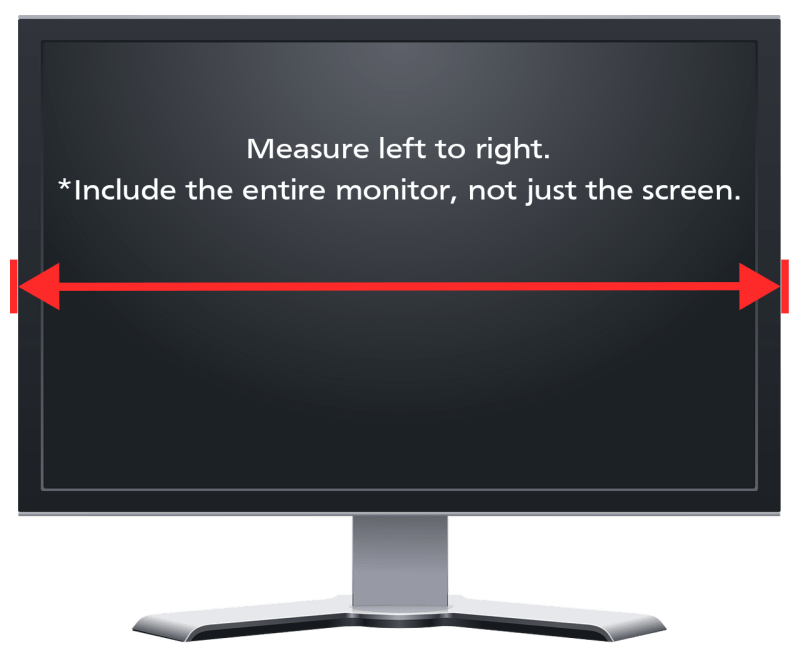
#5 How would you like your monitors to be configured on the monitor mount?
There are a variety of ways to arrange your computer monitors. It's important for you to decide if there's a specific configuration you need for your monitor set up.
Below show some of the most common configurations for one, two, three, four, six, and eight monitor setups. To keep it simple, the examples show the monitors in a landscape layout rather than portrait (many configurations have the option for portrait layout, too).
If you’re not seeing the exact monitor arrangement you're looking for in the examples below, you may need to work with a manufacturer to create a custom system.
One Monitor Configuration

Two Monitor Configurations

Three Monitor Configurations

Four Monitor Configurations

Six Monitor Configurations

Eight Monitor Configurations

#6 What is the width of your desk?
Something that can be easily overlooked is how the width of your monitor setup compares to the width of your actual desk.
This is going to be important for those who have either of these two desk layouts:
1. A wall, cubicle, or some other object is right up against the left and right side of the desk
2. You're using a standing desk and have stationary objects on either side of it that would get hit by an overhanging monitor
If you fall into either of those groups, you'll need to make sure the width of your monitor arm system is equal to or less than the width of your worksurface. If you find that's not the case, you may want to consider using fewer monitors or changing the configuration.
First, measure the width of your monitor arm system. To do this, you'll need to have the proper monitor measurement (left to right) and know the system's configuration.
To help you do this, here's an example.
Let's say you want to mount four 25" wide monitors (remember this is the left to right measurement, not diagonal screen size). You've chosen a 4x1 configuration. This particular system allows the screens to be right next to each other (minimal gap). We are also assuming the screens will be in a straight line, not curved.

To calculate the width, multiply the monitor width by the number of monitors in the line.
25" wide x 4 monitors = 100" total width of the monitor arm system
Secondly, measure the width of your desk's worksurface.
To continue with the example, let's say the worksurface is 72" wide.
Lastly, compare the two. Are your monitors going to hang over the sides of your worksurface?
For our example, the monitor arm system is 28" wider than the worksurface (100" - 72" = 28" of overhang). If the system is centered on the desk, that means there will be 14" of hangover on either side of the desk.

That's a significant amount of overhang. Even if you did have open space on either side of the desk, you'll likely experience instability and constantly cranking your neck just to see the outer screens. This is the case where you will likely want to use one less monitor (3x1 configuration) or change to an alternative 4 monitor configuration (2x2 or 1 over 3).
#7 Are you looking to simply get your monitors off your desk or for a mount with more adjustability options?
If you're just looking for something to get your monitors off your desk, then a simple post system may be the right fit for you. It's a simple, no-frills monitor arm option for those who don't need a bunch of adjustment options.
Sound like what you're look for? Feel free to skip ahead to #11.
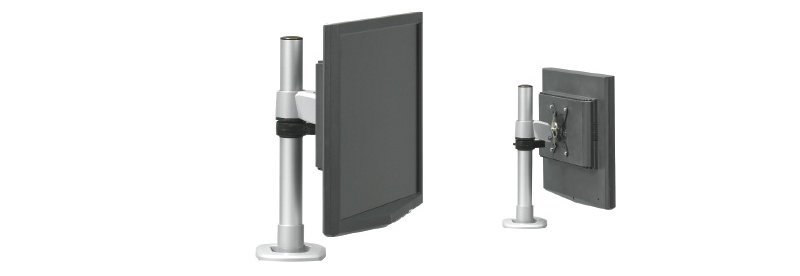
However, if you want some more flexibility and adjustment in your monitor arms, there are a number of features available. Types of adjustments include:
- Height adjustment
- Depth adjustment
- Rotation
- Tilt / Swivel
- Modularity (system can be reconfigured by purchasing parts and pieces, rather than an entirely new mounting system)
To help give you a better idea of your options, see the descriptions of the adjustment types below.
Height Adjustment
Monitor arms that offer height adjustability generally fall within one of these four categories.
- Gas monitor arm
Internal mechanism includes a gas cylinder that allows users to move monitors with their hands. - Spring monitor arm
Internal mechanism includes a spring that allows users to move monitors with their hands. - Electric monitor arm
Similar to a sit stand desk, this type of monitor arm can change heights by simply pushing a button. - Post with adjustable bracket
A bracket is used to attach the monitors to the post. That bracket can be manually slid up or down the post to change the monitor heights.
We'll dig into these a bit more in #8 to help you find your best fit.
Depth Adjustment
The distance between you and your monitors can be changed by using what's called a monitor arm extension. Extensions allow you to manually push a monitor further away or pull it closer.
So, how many extensions do you need?
If you're looking to have a true push or pull movement, your mounting system should include two extensions. Using only one extension will cause the monitor to simply slide over.
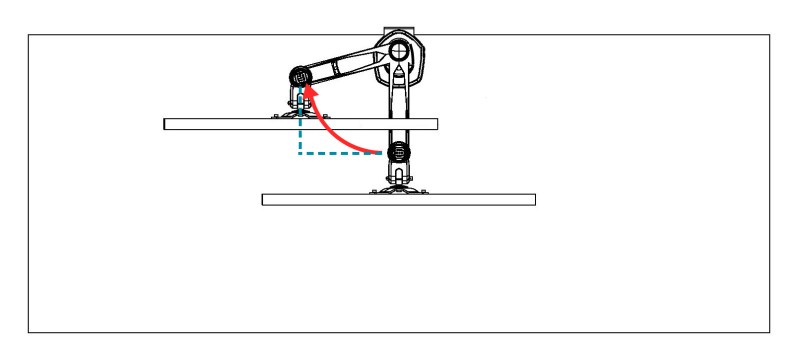
Rotation
Most monitor arm mounts have 360° rotation capabilities. This means that you can easily change your monitor from landscape to portrait, or turn it to show your screen to a fellow colleague.
Tilt / Swivel
Almost all monitor arm mounts will allow for users to tilt or swivel their monitors to a comfortable viewing angle. The amount of tilt adjustment will depend on the mount, so make sure to check the specifications of each make and model.
Modular Monitor Mounts
Modular monitor arm systems make it simple for users to change the monitor mounts as their needs or preferences change.
If you wanted to add another monitor, you could just purchase a few additional parts and pieces to adapt your existing system. But for those with an all-in-one / non-modular setup, you'd be required to purchase an entirely new mounting system.
Modular mounting systems are ideal for environments where users may move from one desk to another or where the office layout may be reconfigured. It helps to give additional flexibility and makes any mounting adjustments much easier.
#8 How often are you needing to adjust the height of your monitors?
There are various types of monitor arms that allow you to adjust your monitor height - gas, spring, electric, or post with adjustable brackets (discussed in #7).
How do you know which one to choose? One way is by figuring out how often you'll needing to change the height of your monitors.
I rarely adjust my monitor height
Most users fall into this category - once you get your monitor arm setup just how you like it, you leave it be for quite a while. While you may slightly change the tilt or rotation of the monitor, the height is usually kept the same.
This is typical for those who work at single-user workstations.
Here's your best fit: a post mount with an adjustable bracket
A post mount allows users to chose their desired monitor height, but it is not easily changed once it has all been setup. This makes it perfect for those who set it up and don't need to frequently adjust the monitor height.
With that said, post mounts still allow for easy depth adjustment (just add extensions) or a change in tilt and rotation.
I frequently adjust my monitor height
For multi-user workstaions or those who just need to change their monitor height often, you'll want to choose between a gas, spring, or electric monitor arm system.
Gas & Spring Monitor Arm
If you only have a one, two, or three monitor setup, a gas or spring monitor arm will work well for you. This includes setups that allow monitors to move independently or if the monitors share a bracket.
For those who have three or more monitors, look for a gas or spring arm that enables you to move all monitors at the same time (unless you need them to move independently).
If all monitors move in sync, you won't have to worry about making sure they line up properly. With independent arms, you have to move each monitor individually and try to align them. This can become a bit of an annoyance for users with multiple monitors.
Should you choose a gas or spring arm? They both function similarly, so it will ultimately come down to which manufacturer and/or monitor configuration you choose.
At RightAngle, for example, we offer both a gas and spring monitor arm. Our gas model is an all-in-one system (not modular), monitors move together (share a bracket), and is preferred for more shallow workstations. Conversely, our spring arm is part of a modular system (mix & match to create your ideal system) and each monitor can move independently.
But, other manufacturers and resellers will have gas arms that are modular or spring arm setups that fit shallow workstations well.
Electric Monitor Arm
The electric monitor arm is the ideal system for multi-user and multi-monitor workstations. Adjust the height of all monitors at the same time by pushing a button.
Similar to the post, spring, and gas options, the electric monitor arm allows users to have flexibility in depth, tilt, and rotation adjustments. Below is a video to see an electric monitor arm in action.
This is especially helpful for users working within a lab, security, financial trading, healthcare, and other environments that use large, heavy computer monitors.
#9 Is the back of your desk up against a wall or cubicle?
Workstations that are flush against a wall are a bit more limited in monitor arm options. This is because the monitor arms aren't able to extend beyond the back of the desk.
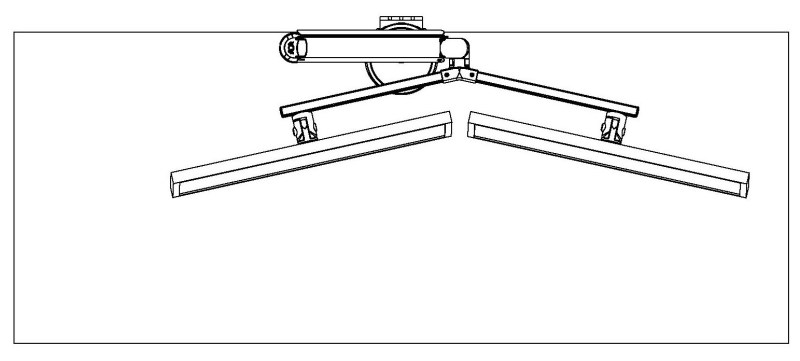
If you answered yes to that question, you'll want to look for a more shallow monitor mount so you can create enough distance between you and your computer screen. This will be the case for most users who's desk is in this environment, unless you have an extremely deep worksurface.
A single post mount without extensions will help to maximize the distance between you and your monitor. If you want to have some depth adjustment options, you can add a single extension arm per monitor.
Trying to use two extensions per monitor will likely cause your monitors to be too close to you as you work. Two or more extensions is better suited for environments where there is open space them to go beyond the back of the worksurface.
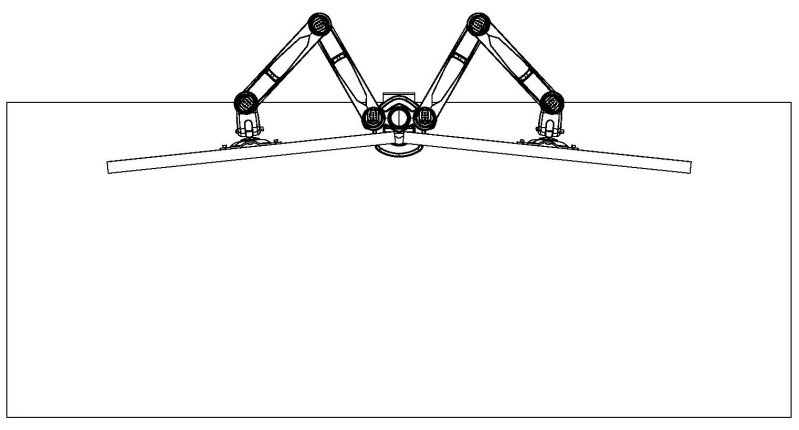
#10 Will your monitor arm be placed in a corner of an L or U shaped desk?
Placing a monitor mount in a corner of an L or U shaped desk deepens the worksurface. This means you'll have less issues with pushing your monitors back far enough as was mentioned in #9.
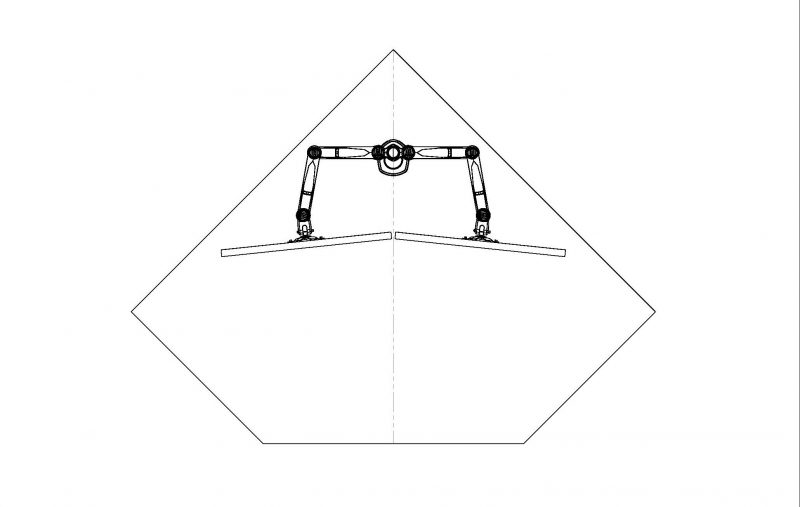
If you answered yes to the question, here are a few notes.
1. Make sure you have a sufficient number of extension arms to bring your computer screens close enough for you to see.
2. You're better off using a grommet mount (monitor arm is secured by creating a hole in the worksurface. Using a clamp creates a lot more depth that would need to be overcompensated by adding more extension arms.
#11 How do you want to mount your monitor arm(s) - Grommet or Clamp?
Grommet mounts are the preferred option. This is where you create a hole in your worksurface and the mount goes through it.
A grommet mount gives you more flexibility to put your monitor arms in your ideal spot, it helps with depth issues (pushing monitor back far enough), and wire management is cleaner and more manageable.
If for some reason a grommet mount isn't possible, a clamp mount will do just fine.
#12 What is your budget for a monitor mount?
When it comes to monitor arms, cost is a bit all over the map. When it comes to creating a budget for a new monitor arm mount, here are a few things to keep in mind.
- The more features and bells & whistles, the more expensive the mount will be.
- Often times, lower cost monitor mounts will be less stable and have more bounce to them (move while you're working).
- More assembly required usually translates to lower cost.
- You get what you pay for.
- If a standard, off the shelf system won't fit your needs, you may need to spend more money for a custom system.

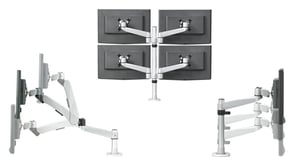
COMMENTS